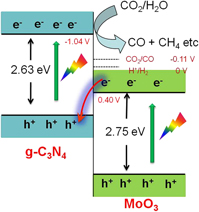Crossref Citations
This article has been cited by the following publications. This list is generated based on data provided by
Crossref.
Liu, Shuilian
Chen, Jianlin
Xu, Difa
Zhang, Xiangchao
and
Shen, Mengyao
2018.
Enhanced photocatalytic activity of directZ-scheme Bi2O3/g-C3N4composites via facile one-step fabrication.
Journal of Materials Research,
Vol. 33,
Issue. 10,
p.
1391.
Kumar, Santosh
Karthikeyan, Sekar
and
Lee, Adam F.
2018.
g-C3N4-Based Nanomaterials for Visible Light-Driven Photocatalysis.
Catalysts,
Vol. 8,
Issue. 2,
p.
74.
Liu, Xingqi
and
Cai, Li
2018.
Novel indirect Z-scheme photocatalyst of Ag nanoparticles and polymer polypyrrole co-modified BiOBr for photocatalytic decomposition of organic pollutants.
Applied Surface Science,
Vol. 445,
Issue. ,
p.
242.
Qiao, Qing
Yang, Ke
Ma, Li-Li
Huang, Wei-Qing
Zhou, Bing-Xin
Pan, Anlian
Hu, Wangyu
Fan, Xiaoxing
and
Huang, Gui-Fang
2018.
Facile in situ construction of mediator-free direct Z-scheme g-C3N4/CeO2 heterojunctions with highly efficient photocatalytic activity.
Journal of Physics D: Applied Physics,
Vol. 51,
Issue. 27,
p.
275302.
Shen, Meng
Zhang, Lingxia
and
Shi, Jianlin
2018.
Converting CO2 into fuels by graphitic carbon nitride-based photocatalysts.
Nanotechnology,
Vol. 29,
Issue. 41,
p.
412001.
Wang, Mengjun
Liu, Chao
Zhang, Xiaobo
Fan, Zichun
Xu, Jiasheng
and
Tong, Zhiwei
2018.
In situ synthesis of CsTi2NbO7@g-C3N4 core–shell heterojunction with excellent electrocatalytic performance for the detection of nitrite.
Journal of Materials Research,
Vol. 33,
Issue. 23,
p.
3936.
Song, Yiming
Li, Jun
and
Wang, Chen
2018.
Modification of porphyrin/dipyridine metal complexes on the surface of TiO2 nanotubes with enhanced photocatalytic activity for photoreduction of CO2 into methanol.
Journal of Materials Research,
Vol. 33,
Issue. 17,
p.
2612.
Zhang, Peng
Dong, Zhiyuan
Ran, Yuanming
Xie, Hualin
Lu, Yun
and
Ding, Shimin
2018.
Preparation and photocatalytic application of AgBr modified Bi2WO6 nanosheets with high adsorption capacity.
Journal of Materials Research,
Vol. 33,
Issue. 23,
p.
3953.
Jiang, Xiaole
Ma, Yueying
Zhao, Chunran
Chen, Yijing
Cui, Min
Yu, Jingxiong
Wu, Ying
and
He, Yiming
2018.
Synthesis of flower-like AgI/Bi5O7I hybrid photocatalysts with enhanced photocatalytic activity in rhodamine B degradation.
Journal of Materials Research,
Vol. 33,
Issue. 16,
p.
2385.
Wang, Jie
Ren, LiZhen
Zhang, DongEn
Hao, XiaoYun
Gong, JunYan
Xiao, Xin
Jiang, YouXiang
and
Tong, ZhiWei
2018.
Fabrication of Bi2MoO6/BiOI heterojunction photocatalysts for enhanced photodegradation of RhB.
Journal of Materials Research,
Vol. 33,
Issue. 23,
p.
3928.
Wang, Meng
Peng, Zhijian
Li, Hong
Zhao, Zengying
and
Fu, Xiuli
2018.
C fibers@MoO2 nanoparticles core–shell composite: Highly efficient solar-driven photocatalyst.
Journal of Materials Research,
Vol. 33,
Issue. 6,
p.
685.
Wang, Shuaijun
He, Fengting
Dong, Pei
Tai, Zhaoxin
Zhao, Chaocheng
Wang, Yongqiang
Liu, Fang
and
Li, Lin
2018.
Simultaneous morphology, band structure, and defect optimization of graphitic carbon nitride microsphere by the precursor concentration to boost photocatalytic activity.
Journal of Materials Research,
Vol. 33,
Issue. 23,
p.
3917.
Ma, Yunfeng
Yang, Lili
Yang, Yong
Peng, Yusi
Wei, Yuquan
and
Huang, Zhengren
2018.
Multifunctional Ag-decorated g-C3N4 nanosheets as recyclable SERS substrates for CV and RhB detection.
RSC Advances,
Vol. 8,
Issue. 39,
p.
22095.
Wang, Yunke
Hu, Shaozheng
Li, Qiang
Gu, Guizhou
Zhao, Yanfeng
Liang, Hongyu
and
Li, Wei
2018.
One step synthesis of high-efficiency AgBr–Br–g-C3N4composite catalysts for photocatalytic H2O2productionviatwo channel pathway.
RSC Advances,
Vol. 8,
Issue. 64,
p.
36903.
Mian, Md Manik
Liu, Guijian
Yousaf, Balal
Fu, Biao
Ahmed, Rafay
Abbas, Qumber
Munir, Mehr Ahmed Mujtaba
and
Ruijia, Liu
2019.
One-step synthesis of N-doped metal/biochar composite using NH3-ambiance pyrolysis for efficient degradation and mineralization of Methylene Blue.
Journal of Environmental Sciences,
Vol. 78,
Issue. ,
p.
29.
Zhu, Bangtong
Xu, Guangqing
Li, Xia
Wang, Zhiwei
Lv, Jun
Shu, Xia
Huang, Jun
Zheng, Zhixiang
and
Wu, Yucheng
2019.
Ultrathin porous g-CN nanosheets fabricated by direct calcination of pre-treated melamine for enhanced photocatalytic performance.
Journal of Materials Research,
Vol. 34,
Issue. 20,
p.
3462.
Peng, Li
Li, Zi-wei
Zheng, Ren-rong
Yu, Hui
and
Dong, Xiang-ting
2019.
Preparation and characterization of mesoporous g-C3N4/SiO2 material with enhanced photocatalytic activity.
Journal of Materials Research,
Vol. 34,
Issue. 10,
p.
1785.
Yan, Xuehua
Yuan, Xiaoxue
Wang, Jinging
Wang, Qiong
Zhou, Chen
Wang, Dongfeng
Tang, Hua
Pan, Jianmei
and
Cheng, Xiaonong
2019.
Construction of novel ternary dual Z-scheme Ag3VO4/C3N4/reduced TiO2 composite with excellent visible-light photodegradation activity.
Journal of Materials Research,
Vol. 34,
Issue. 12,
p.
2024.
Ismael, Mohammed
Wu, Ying
and
Wark, Michael
2019.
Photocatalytic activity of ZrO2 composites with graphitic carbon nitride for hydrogen production under visible light.
New Journal of Chemistry,
Vol. 43,
Issue. 11,
p.
4455.
Zheng, Yinan
Yin, Xiaohong
Jiang, Yue
Bai, Junsong
Tang, Yuan
Shen, Yongli
and
Zhang, Ming
2019.
Nano Ag‐Decorated MoS2 Nanosheets from 1T to 2H Phase Conversion for Photocatalytically Reducing CO2 to Methanol.
Energy Technology,
Vol. 7,
Issue. 11,
